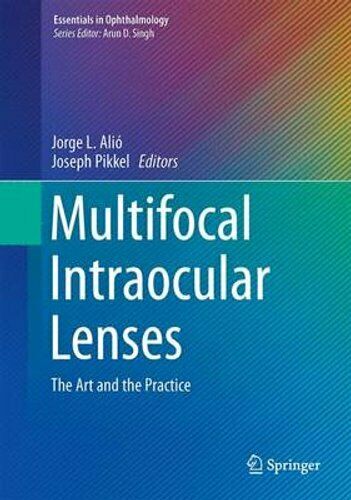A comprehensive review of multifocal treatment

Leigh Spielberg
Published: Wednesday, April 8, 2020
 Multifocal intraocular lenses are all the rage. Patients have become accustomed to the possibility of spectacle independence and increasingly request this option. However, successful implantation of multifocal lenses is more than simply a surgical procedure. There are dozens of different lenses and just as many types of patients, and matching the correct IOL with the correct patient is a skill unto itself.
This is where Multifocal Intraocular Lenses: The Art and the Practice, Second Edition (Springer) comes in. Edited by Jorge L. Alió and Joseph Pikkel, this 380-page text is a comprehensive overview of all aspects of multifocal treatment, from the preoperative assessment to suggested solutions for the unhappy patient.
The text starts with a short introduction on what multifocal lenses can offer in the current era. What follows is an in-depth coverage of everything that requires consideration before implantation of a multifocal lens.
Chapter 3 reviews the basic principles, Chapter 4 the preoperative considerations and Chapter 5 covers the neuroadaptation required for a patient both to get used to and enjoy their newly recovered multifocality. “Implanting a multifocal intraocular lens is, in a way, a ‘disturbance’ that makes it more difficult for the brain to create a well-detailed image.” Because the neuroplasticity required for neuroadaptation decays with age, “patient selection is absolutely a key factor in gaining a satisfactory outcome. Ignoring neuroadaptation may result in prolonged patient complaints.”
Particularly interesting was the chapter entitled “Considerations in Special Cases”. These include children, patients with glaucoma, maculopathy, amblyopia and dry eye. Patients who have undergone corneal refractive surgery are also considered.
Of course, surgery isn’t surgery without complications, and these are covered in Chapter 8, which is followed by a chapter on post-implantation residual refractive error and another one on “Solutions for the Unhappy Patient”. This might be the most useful chapter.
The second half of the book is devoted to information on each of the available lens types, including EDOF and accommodative IOLs.
Intended for ophthalmologists who currently implant multifocal IOLs or plan to do so in the future.
Multifocal intraocular lenses are all the rage. Patients have become accustomed to the possibility of spectacle independence and increasingly request this option. However, successful implantation of multifocal lenses is more than simply a surgical procedure. There are dozens of different lenses and just as many types of patients, and matching the correct IOL with the correct patient is a skill unto itself.
This is where Multifocal Intraocular Lenses: The Art and the Practice, Second Edition (Springer) comes in. Edited by Jorge L. Alió and Joseph Pikkel, this 380-page text is a comprehensive overview of all aspects of multifocal treatment, from the preoperative assessment to suggested solutions for the unhappy patient.
The text starts with a short introduction on what multifocal lenses can offer in the current era. What follows is an in-depth coverage of everything that requires consideration before implantation of a multifocal lens.
Chapter 3 reviews the basic principles, Chapter 4 the preoperative considerations and Chapter 5 covers the neuroadaptation required for a patient both to get used to and enjoy their newly recovered multifocality. “Implanting a multifocal intraocular lens is, in a way, a ‘disturbance’ that makes it more difficult for the brain to create a well-detailed image.” Because the neuroplasticity required for neuroadaptation decays with age, “patient selection is absolutely a key factor in gaining a satisfactory outcome. Ignoring neuroadaptation may result in prolonged patient complaints.”
Particularly interesting was the chapter entitled “Considerations in Special Cases”. These include children, patients with glaucoma, maculopathy, amblyopia and dry eye. Patients who have undergone corneal refractive surgery are also considered.
Of course, surgery isn’t surgery without complications, and these are covered in Chapter 8, which is followed by a chapter on post-implantation residual refractive error and another one on “Solutions for the Unhappy Patient”. This might be the most useful chapter.
The second half of the book is devoted to information on each of the available lens types, including EDOF and accommodative IOLs.
Intended for ophthalmologists who currently implant multifocal IOLs or plan to do so in the future.
Tags: multifocal IOLs
Latest Articles
Beyond the Numbers
Empowering patient participation fosters continuous innovation in cataract surgery.
Thinking Beyond the Surgery Room
Practice management workshop focuses on financial operations and AI business applications.
Picture This: Photo Contest Winners
ESCRS 2025 Refractive and Cataract Photo Contest winners.
Aid Cuts Threaten Global Eye Care Progress
USAID closure leads retreat in development assistance.
Supplement: ESCRS Clinical Trends Series: Presbyopia
Nutrition and the Eye: A Recipe for Success
A look at the evidence for tasty ways of lowering risks and improving ocular health.
New Award to Encourage Research into Sustainable Practices
Sharing a Vision for the Future
ESCRS leaders update Trieste conference on ESCRS initiatives.
Extending Depth of Satisfaction
The ESCRS Eye Journal Club discuss a new study reviewing the causes and management of dissatisfaction after implantation of an EDOF IOL.
Conventional Versus Laser-Assisted Cataract Surgery
Evidence favours conventional technique in most cases.